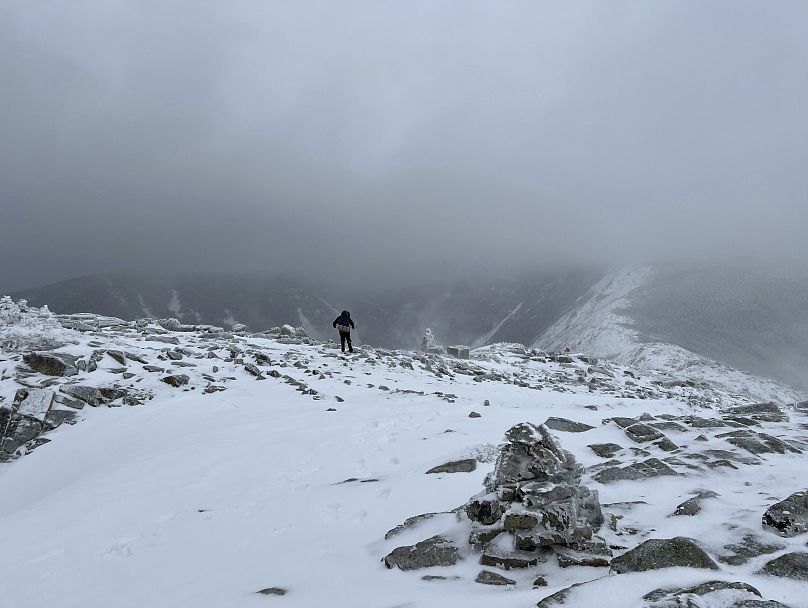‘If we take care of nature, nature will take care of us’ said Christopher Roma, one of almost 100 people to die during the extreme winter storms.
A nature-loving hiker died during brutal conditions while on a solo hike in America’s White Mountains last week.
Christopher Roma, 37, was an expert hiker who ran his own long-distance trail guide business and had walked this familiar route in New Hampshire many times before.
But he is one of more than 90 people who lost their lives in the US over the past week as the country has been battered by ferocious winter storms.
“Once you get to a certain point, you have to make that choice to continue or turn back,” his mother, Barbara Roma, said. “And he was never really a turning-back kind of kid.”
Christopher had previously achieved the “Triple Crown” of challenging cross-country trails: the Pacific Crest Trail between Mexico and Canada, the Continental Divide Trail along the length of the Rocky Mountains, and the Appalachian Trail.
Between Tuesday (16 January) and Wednesday, he died in what Barbara describes as “whiteout conditions” with single-digit temperatures, harsh winds up to 80mph and waist-deep snow.
Lifelong hiker knew ‘the importance of sustainability’
Born in England, Christopher moved when he was five with his family to Thornton, in the heart of the White Mountains, where he grew up skiing, snowboarding, snowshoeing and hiking the challenging terrain.
A bad motorcycle accident 10 years ago broke his neck and ribs, but that didn't stop him, his father, Hayden Roma, told The Associated Press (AP) in an interview on Friday.
“That changed his whole life,” his father said. Following his recovery, he dedicated himself to hiking, conquering the “Triple Crown” of hiking in 99 days. "He was doing over 20, 22 miles a day," his father said.
Christopher, who ran the Northeast Trekking Company, a guide service for long-distance hikers, said on his website that his hiking experiences transformed him and he wanted to share his knowledge with others.
“I experienced a lot of learning the hard way, and my goal is to educate and inform you about the dangers of the wild, the trials and tribulations, and the importance of sustainability,” he wrote. “I want to show you that if we take care of nature, nature will take care of us, mentally and physically.”
Christopher's mother said he "was always wanting to achieve more” and loved his family, enjoying hiking with his 2-year-old son, Solomon.
His sister, Megan Roma Sullivan, fondly recalled how he interacted with people on their last hike together in August, along Hadrian's Wall near the border of England and Scotland.
“He always cared about people and wanted what's best for them, to change their lives basically every time they would have a hike," she said. "They would have good conversations.”
What went wrong on the New Hampshire trail?
Christopher had hiked all 48 of New Hampshire's 4,000-foot mountains, a 250-mile (400-kilometre) trek, in a little over 10 days, he said in his blog.
“He was trying to beat a personal best, I think - he was trying to work on doing it in a certain time. He just got caught in some freak weather," Barbara said of his last hike. "The winds really picked up. They were up to 80 miles an hour at one point," she said.
Concerned friends started calling 911 at about 10.20pm on Tuesday after speaking with him by phone. Christopher himself eventually reached the emergency line saying he was very cold.
That call enabled authorities to get coordinates placing him between Mount Bond and Mount Guyot.
A large team of Fish and Game conservation officers and search and rescue squads assembled, and set out as of 2am Wednesday, but was slowed by blowing snow.
A New Hampshire Army National Guard helicopter crew made three separate flights, but couldn't get near the targeted area on Mount Guyot because of low clouds and poor visibility, Lt. James Kneeland of the Fish and Game Department said.
By the time ground crews reached Roma at 5pm, he was dead. The helicopter was able to recover his body on Thursday morning, saving what would have been a difficult carry-out for 15 conservation officers and more than 30 volunteers who were on their way to him.
Is climate change making US winter storms worse?
There have been 92 weather-related fatalities across the US in the last week, according to the CBS news network.
Travel has been disrupted and thousands of people left without power after freezing air from the Arctic brought record low temperatures and fierce winds to the States.
Some scientists say that changes to the Arctic - which is warming three to four times faster than the rest of the planet - are making winter extremes in the US more likely.
“When the Arctic is off-the-charts warm (like now), we’re more likely to see frigid cold invade places like Texas that are ill-equipped to deal with it,” Jennifer Francis, a Woodwell Research Center climate scientist, told AP last week.
Francis is a pioneer in the theory of Arctic Amplification, which links the cold outbreaks to the climate crisis by tracking changes in the polar vortex (the circulation of winds high up in the stratosphere) and the jet stream (lower down in the atmosphere, and a key driver of weather).
“Rapid Arctic warming is one of the clearest symptoms of human-caused climate change, making winter extremes more likely even as the globe warms overall,” she adds.
Ice storm and other winter weather warnings remain in place across a number of US states today including Arkansas, Oklahoma and Oregon.
But the cold snap is set to fade in the coming days, to be replaced by unusually warm weather.
Some meteorologists have warned that the thaw could cause flooding in parts of the Midwest and north-eastern US.












